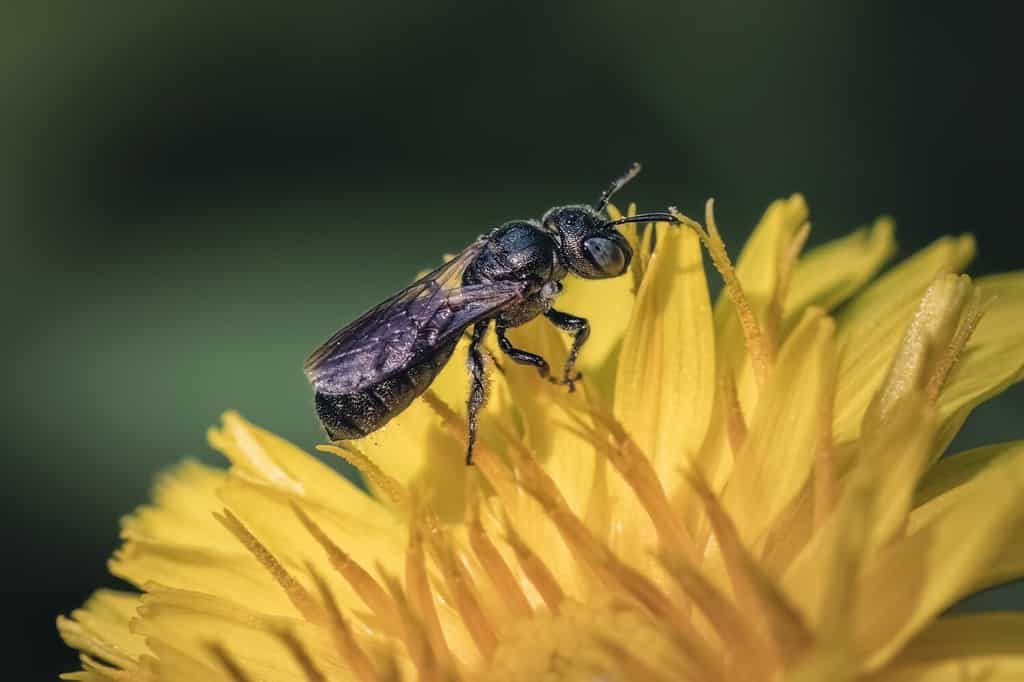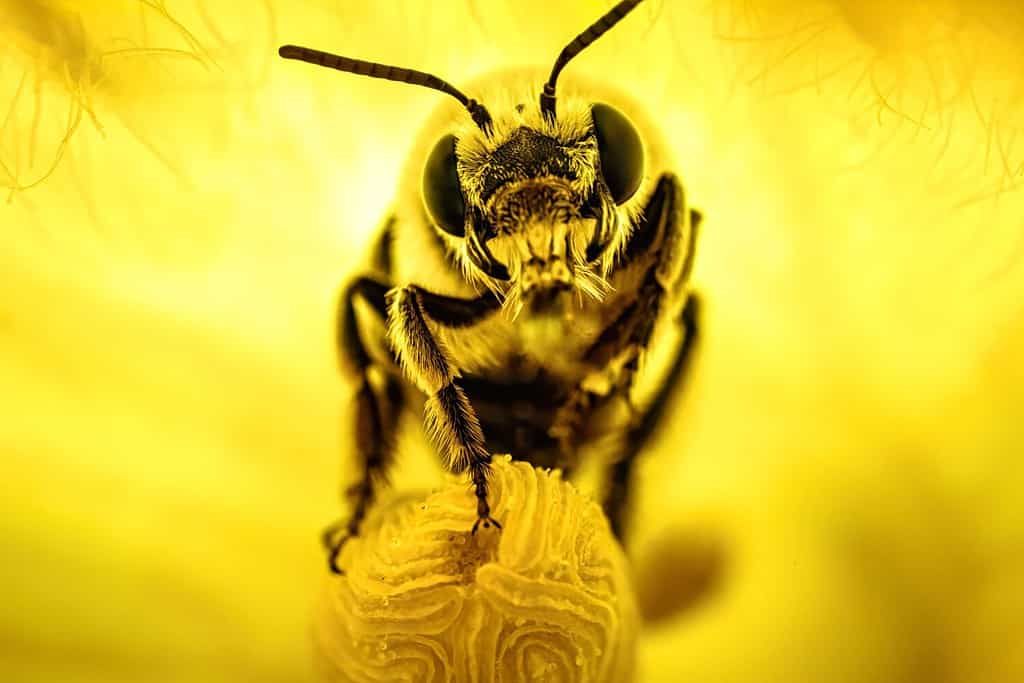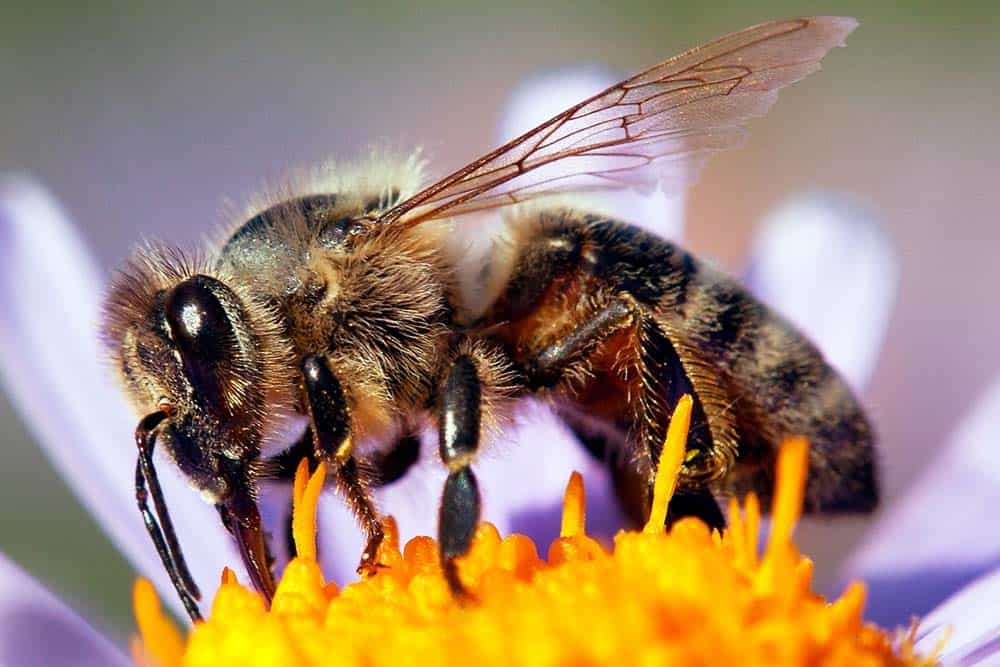Bees are truly captivating creatures, yet those who have experienced their stings know the encounter can be quite unpleasant.
The state of Louisiana is home to a wide variety of bee species. Each species possesses distinct traits, including the intensity of its sting. Some of these bees deliver such a powerful sting that the inflicted pain can persist long after the initial contact. And others may not hurt much at all!
In this article, we will delve into six of the bee species inhabiting Louisiana. We’ll classify them based on the potency of their stings. Let’s start with the least painful sting of the bunch and move up to the most painful!
6. Small Carpenter Bee (Ceratina spp)

While male carpenter bees can exhibit aggressive behavior, they are harmless due to the absence of a stinger.
©Victoria Virgona/Shutterstock.com
Small carpenter bees, which belong to the Ceratina genus, possess a unique characteristic that distinguishes them from other bees. Often perceived as nuisances, these bees are actually vital in pollinating a variety of wildflowers, fruit trees, and garden plants. Their pollination efforts are essential for generating new plant growth. With 366 species found worldwide, Ceratina is an extensive and globally distributed genus.
They can be easily identified by their black hue with hints of bluish-green or blue. Occasionally, they may exhibit yellowish-white markings on their face, thorax, and legs. Measuring no more than 3/8 inch in length, these bees are much smaller than other carpenter bees. Carpenter bees are unable to bore through hard wood, so they nest in hollow twigs or those with a soft pith, such as raspberry, teasel, elderberry, or brambles.
The burrows created by small carpenter bees consist of individual nest cells, each stocked with pollen and nectar. It is worth noting that multiple different species of Ceratina bees may choose to nest in the same vicinity. These bees are polylectic, which indicates that they gather pollen from a variety of flowers across different plant groups. They are also generalists when collecting nectar.
While male carpenter bees can exhibit aggressive behavior, they are harmless due to the absence of a stinger. Conversely, female carpenter bees have a stinger but rarely use it unless provoked or handled.
They are listed on a scale of 1 on the Schmidt insect sting pain index. A sting results in immediate sharp pain and a burning sensation at the site and the surrounding area.
5. Squash Bee (Peponapis pruinosa)

Their role in the ecosystem is vital because they depend entirely on
Cucurbitaplants for pollen to feed their offspring.
©Joseph Burdick/Shutterstock.com
If you cultivate squash like pumpkins or zucchinis, you may be well acquainted with squash bees. These expert pollinators exclusively visit Cucurbita plant blossoms. These bees are distinguishable by their black color, whitish bands on the abdomen, and yellowish hairs covering their bodies. In addition, the scopae on their hind legs helps to transport the coarse pollen of cucurbits.
Squash bees measure about half an inch in length. Peponapis pruinosa inhabit areas from Quebec to Mexico, including Louisiana, where squashes grow.
Squash bees are not social insects, but they do nest together on the ground. Every female squash bee digs her own nest. Their role in the ecosystem is vital because they depend entirely on Cucurbita plants for pollen to feed their offspring. Conversely, other pollinators visit a multitude of flowers. Male squash bees search for mates by darting between flowers and then rest inside wilted flowers around noon.
Sadly, specific species of squash bees, such as the Kansas squash bee (Xenoglossa kansensis), have been declining. However, due to the insufficient population data on squash bees, it is difficult to assess the overall situation.
Despite their seemingly aggressive flight behavior, squash bees are relatively gentle and only sting when provoked. Females tend to fly away instead of fighting, while males are stingless. The rating of squash bee stings is only 1 on the Schmidt insect sting pain index.
4. Digger Bee (Anthophorini)

These bees are social solitary bees. They nest individually but in close proximity to one another, creating the appearance of a colony.
©Michael Siluk/Shutterstock.com
Digger bees are part of the Apidae family, with the Anthophorini tribe being a prominent group within this subfamily. These bees are recognized by their fuzzy appearance and the way they nest in the soil, earning them the name “digger” bees.
While the United States is home to around 70 digger bee species, each one possesses unique characteristics, allowing for identification beyond their general traits.
Digger bees can be anywhere from 1/4 to 1/2 inch in size. Though most have a fuzzy texture, some may display a shiny or metallic look. The markings, patterns, and fur on these bees are also specific to each specie. Males are identifiable by their enlarged antennae.
It is worth mentioning that not all ground-nesting bees are digger bees, despite their similar nesting habits. Bumblebees and carpenter bees, for instance, are ground-nesters but not digger bees. Digger bees are considered social solitary bees. In other words, they nest individually but in close proximity to one another, creating the appearance of a colony.
More aggressive ground-nesting insects, such as yellowjackets, are sometimes confused with the docile digger bees. Therefore, if you come across mounds in or around your property, it’s crucial to exercise extra caution. You may be dealing with wasps instead of bees.
Digger bees differ from honeybees in that they do not produce honey. They are generally docile and not prone to aggression, although they may attack if threatened. According to the Schmidt pain index, digger bee stings are among the least painful, receiving a rating of 1.
3. Asiatic Honeybee (Apis cerana)
The medium-sized bee species Asiatic honey bee, indigenous to certain Asian regions, has appeared as an invasive insect in Louisiana. While Apis cerana and Apis mellifera exhibit similar physical and behavioral features, they are classified as distinct species based on the evidence.
These bees measure approximately 0.4 inches in body size and have forewing lengths of about 0.3 to 0.35 inches. The Asiatic honey bee’s appearance closely mirrors that of a western honey bee. The body of the Apis cerana features forked hairs, which are useful for gathering pollen. Moreover, the hind legs of worker bees (non-reproductive females) are equipped with a corbicula. This acts as a pollen basket for the purpose of transporting pollen.
The adult Apis cerana showcases a black and yellow color scheme. Its ovipositor, initially designed for egg deposition, has evolved into a stinger.
These honey bees are capable of thriving in a range of environments, encompassing both natural and human-made habitats. They are particularly attracted to regions abundant in flowering plants, including gardens, forests, fruit groves, and fields. Their primary food sources consist of pollen, nectar, and honey.
When it comes to behavior, Apis cerana is strikingly similar to Apis mellifera, exhibiting a gentle and calm disposition. However, their defensiveness can vary according to the season and location. Apis cerana colonies are more prone to swarming and abandoning their hives compared to Apis mellifera colonies.
These bees may present an ecological hazard as they fight with native fauna and European honey bees for sustenance and nesting spaces.
They can deliver a sting if threatened. Furthermore, their stings can cause anaphylactic reactions in individuals allergic to bee stings. The Schmidt insect sting pain index awards a score of 2 to the sting of an Asian honey bee.
2. Western Honey Bee (Apis mellifera)

Western honey bees are inclined to reside in areas abundant in suitable flowering plants, such as fields, open forests, and gardens.
©Daniel Prudek/Shutterstock.com
The European honey bee, or western honey bee, is the most prevalent species among the eight types of honeybees worldwide. It also holds the distinctive title of Louisiana’s state insect.
The physical characteristics of Apis mellifera encompass a brownish-red hue with black bands and orange-yellow stripes on their abdomen. Their thoraxes are covered in hair, while their abdomens are less so. Equipped with a pollen basket, their hind legs are typically dark brown or black. Worker bees measure roughly 1/2 to 5/8 inch in length, with drones and queens larger in size.
Western honey bees are inclined to reside in areas abundant in suitable flowering plants, such as fields, open forests, and gardens. These bees need cavities for nesting, often found in hollow trees. Pollen and nectar collected from blossoming flowers serve as their primary food sources. They also eat honey (a concentrated form of nectar) and other secretions produced by their colony.
Honey bees are exceptionally important pollinators, playing a crucial role in pollinating numerous plants.
In defense of themselves or their hive, honey bee workers will sting humans and domestic animals. While a single sting can be uncomfortable, it poses no danger unless the individual has an allergy. Any venom allergy can be potentially fatal. It requires approximately 20 stings per kilogram of body weight to present a considerable risk to life. As per the Schmidt insect sting pain index, the honey bee’s sting is ranked a 2.
1. Africanized Honey Bee (Apis mellifera scutellata Lepeletier)

These honey bees are void nesters, residing in hollow tree holes, stumps, and other cavities.
©Goncharov Taras/Shutterstock.com
Africanized honey bees are a hybrid of the African honey bee and the western honey bee. They were first discovered in Louisiana in July 2005. In the United States, they are notorious and commonly referred to as killer bees. These bees initially came from Brazil in the mid-1950s.
Measuring between .04 and 1 inch long, Africanized honey bees are slightly smaller than European honey bees. However, this size difference is hardly noticeable without specific measurements or laboratory testing. The size of this honey bee also varies based on its role within the colony.
Africanized honey bees are void nesters, residing in hollow tree holes, stumps, and other cavities. They construct the hive or nest from wax produced by the glands in worker bees. They build vertically hanging combs ranging in number, depending on the colony’s strength and size.
These bees are exceptional pollinators, feeding on both nectar and pollen from flowering plants. They are dangerous because they attack intruders in significantly greater numbers than European honey bees.
In fact, they have killed approximately 1,000 people, often inflicting 10 times as many stings as the European species. They also react 10 times faster to disturbances than western honey bees, and they have even killed horses and other animals. However, it’s important to note that not all Africanized honey bees are highly aggressive. Their behavior can vary depending on various factors such as environmental conditions, genetics, and colony health.
Africanized honey bees have the capacity to kill humans without bee sting allergies due to their tendency to attack in overwhelming numbers. But those with known bee sting allergies may be at higher risk of severe reactions, including anaphylaxis, which can be life-threatening.
Although they are not on the Schmidt insect sting pain index, they could easily rank at a level 2, similar to most honey bees. However, some may argue that these notorious killer bees may even qualify for a level 3 classification.
The photo featured at the top of this post is © iStock.com/Wirestock
Thank you for reading! Have some feedback for us? Contact the AZ Animals editorial team.







